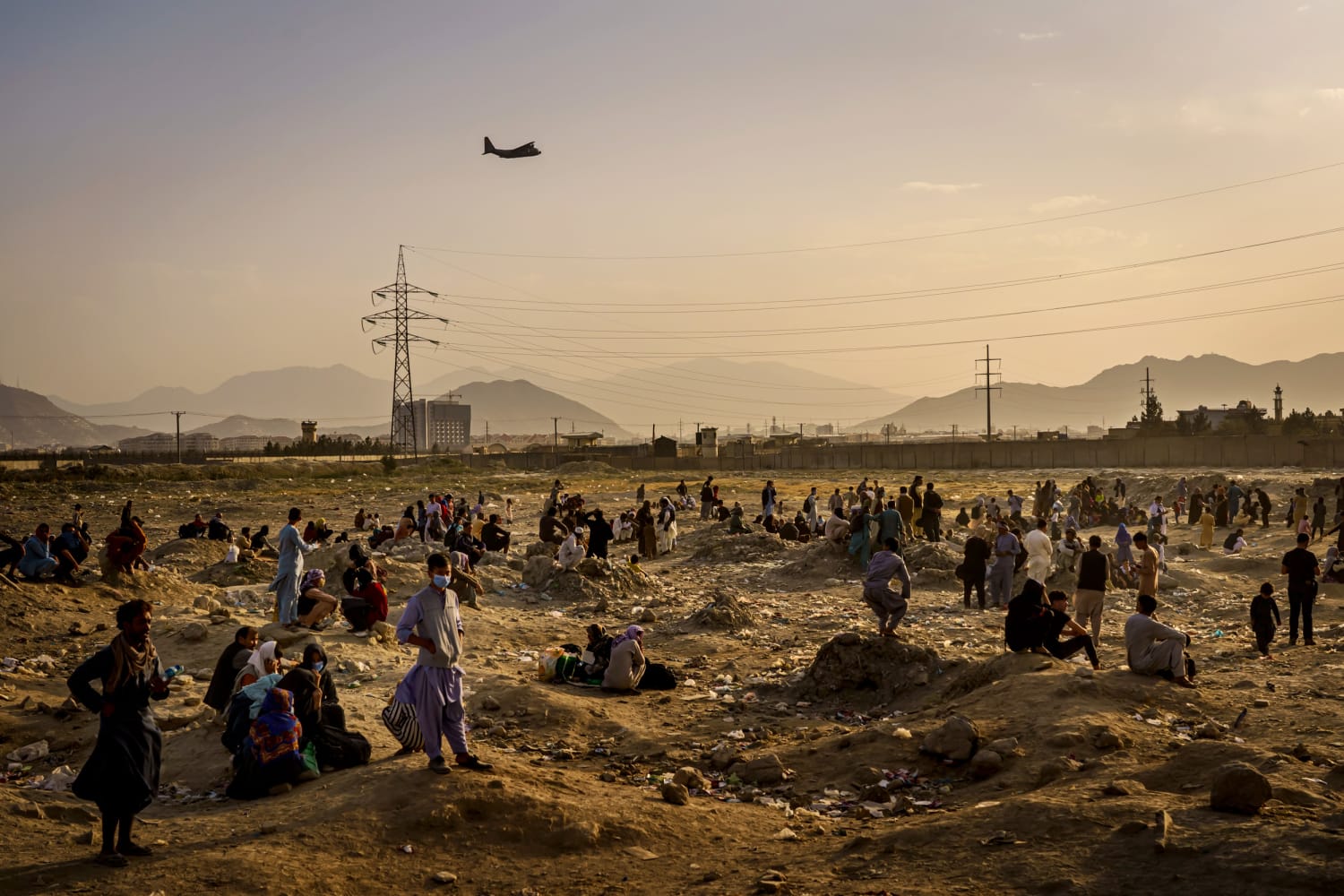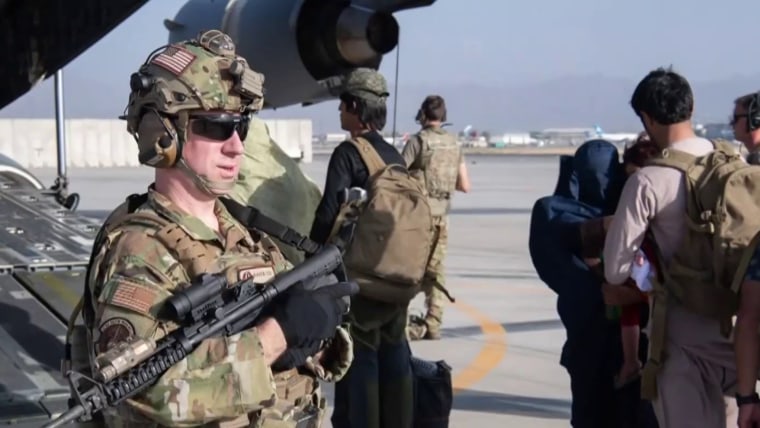A biometric system containing the personal information of millions of Afghans is sparking concern among human rights advocates who worry it could be used by the Taliban to identify and potentially harm people who worked with the U.S.-backed Afghan government or international organizations that promoted women’s rights.
The system, which was created by the United States more than 15 years ago and eventually shared in part with the Afghan government, contains millions of fingerprints, iris scans and face photos of Afghan people who had their biometric data collected by U.S. and coalition forces, who were assigned to enroll as many people as possible.
It originally was meant to contribute to a global effort to identify and track terrorists, by building a database of fingerprints and other identifiers that could be used to track down the source of attacks.
NBC News spoke with three military veterans who worked on the biometrics collection project and who reviewed public documents that detail the extensive program. Each requested anonymity out of concerns about their personal security and in order to discuss sensitive aspects of the biometric system.
If the Taliban do access the U.S.-created datasets as they assume power over Afghanistan and are able to sync them with biometric collection devices, human rights advocates say the data could be curated to create targeted lists of people who worked with coalition forces or international human rights groups in any capacity. Last week, 36 civil society organizations signed a joint letter calling on governments, aid organizations and private contractors that created databases in Afghanistan to take immediate action to shut them down and erase them.
“Under authoritarian regimes, these [biometric] data have been used to target vulnerable people, and digitized, searchable databases amplify the risks of abuse of this data,” the letter reads.
Eric Pahon, a spokesman for the Department of Defense, denied that biometric data is at risk. “The U.S. has taken prudent actions to ensure that sensitive data does not fall into the Taliban’s hands. This data is not at risk of misuse,” he said.
But two U.S. military veterans who worked on the program said there’s a particular fear that any biometric data list could be used specifically to target women. Despite the Taliban’s recent promises to protect the rights of women, female activists have reported being beaten, and the United Nations says the number of women and children killed this year has reached its highest levels since the U.N. started keeping records in 2009 as violence spreads across the country.
“A lot of people are concerned that if there is some way for the Taliban to use the biometrics information, that it could be used to target women who worked in any sort of government position, women police or women journalists,” said one military officer who worked on biometrics collection in Afghanistan.
Large biometric systems have emerged in recent years as a way for governments to create databases of people who can be identified for a variety of means. China has been collecting DNA samples and biometric information from Uyghurs and other predominantly Muslim minority groups who are forced into detainment camps in the western part of the country. Chinese officials have cited the crime-fighting potential of the technology, but human rights advocates fear that the biometric data will be used to intensify the racial profiling, track dissidents or anyone who refuses to conform to the government’s agenda.
In India, the government has worked for years to build the largest biometric identification system in the world, with over a billion people enrolled. The system is used to distribute social services, but has received harsh criticism from advocates for the poor who say its technical glitches have led to denials of benefits that have driven some to starvation.
The U.S. Defense Department would not say how many Afghans are in the system, but veterans who worked on biometrics collection in Afghanistan say it is extensive. One former Air Force medic who worked at an Afghan hospital was told he had to scan the irises, take the fingerprints and photograph the face of every Afghan who came through the hospital doors.
“Men, women, children, dead children, dead bodies, every person I encountered would be put into the biometrics system,” the medic said. He estimates he was responsible for entering more than 1,500 people’s information into the system.
The U.S.-led biometrics collection project in Afghanistan was so sprawling, however, that one Afghanistan War veteran said it may not be of much use. Without people who are trained in how to narrow the datasets, it would be very difficult to make use of them, according to the veteran, who worked on U.S. biometrics collection in Afghanistan and asked to remain anonymous to protect his security.
“Whether you’re in a database or not doesn’t confirm or deny that you have any sort of U.S. allegiance. At its core level, it’s a positive ID. You’re confirming you are who you say you are,” he said.
Unlike a password or an identification card, biometric information, like one’s fingerprints or retinal scan, is much harder to hack or forge, making it a reliable way to positively identify individuals.
‘It was about volume’
The U.S. began the mass collection of biometric data of Afghan people in earnest in 2006. By 2009, the FBI and the U.S. military were already formally sharing the biometric datasets with the U.S.-backed Afghan government and training Afghans how to analyze the data, helping the country build its own biometric system administered by about 50 Afghans at the ministry ofinterior, according to an FBI slideshow viewed by NBC News.
Then in 2011, the U.S. officially handed over some of its biometric datasets to the Afghan government, according to a former U.S. military officer who worked closely on the U.S. program and spoke on the condition of anonymity.
“As far as the initial records, they were on an external hard drive that was hand-carried and handed to a contractor to build and manage the records for the Afghan government,” the former officer said.
Three officers who previously served in the U.S. military in Afghanistan and were tasked with collecting Afghan people’s eye and hand data separately said that they understood the goal was primarily for security forces to have a database of fingerprints to search in case a bomb was found anywhere in the world, for example, and a positive match could be made. The objective, they said, was to scan the irises and fingerprints of as many people as possible. It was part of what President George W. Bush at the time called the “Global War on Terror.”
An early goal of the program in Afghanistan was to capture the biometric information of 80 percent of the country’s population, according to a 2010 State Department report.
The U.S. trained Afghans how to both collect biometric data from individuals and scan the databases to look for matches, according to a 2014 Joint Forces Quarterly report on the scope of the program. Biometric records created by the U.S. were also handed over to Afghan forces as “be on the lookout” lists of insurgents regularly shared with Afghan security forces, according to the report.
“It was about volume. There wasn’t really any targeting of suspicious activity. It was mostly like we know someone in this village who said they can get us a lot of people to come and get enrolled and it will make the commanders happy,” the former officer who worked closely on the U.S. military’s biometrics program in Afghanistan said.
Manuals on eBay
One of the main tools used by U.S. and coalition forces to collect Afghan people’s biometric information in the field was called the handheld interagency identity detection equipment, or HIIDE device. The Intercept reported last week that the devices were seized earlier this month by the Taliban, but whether the Taliban had synced those devices with the biometric databases created by the U.S. remains an open question.
HIIDE machines, which scan fingerprints, irises, face photos and allow for people collecting information to input demographic details, were not hard to come by in Afghanistan, according to the three Afghanistan War veterans. Manuals for how to use the devices are currently for sale on eBay.
Human rights workers said there’s a concern that with the devices and the training the U.S. gave in how to build and access databases, the Taliban could recruit someone who is trained in the program and start to curate and amass datasets of their own. Last week, Human Rights First released a guide on how to protect biometric data from being misused by the Taliban translated into Pashto and Dari, the two primary languages spoken in Afghanistan.
“Now that they have the equipment, they can potentially start their own database,” said Welton Chang, a former Army intelligence officer and chief technology officer at Human Rights First. They can use biometric databases to discriminate against people or create a permanent record that will follow people around.”
Source: | This article originally belongs to Nbcnews.com











